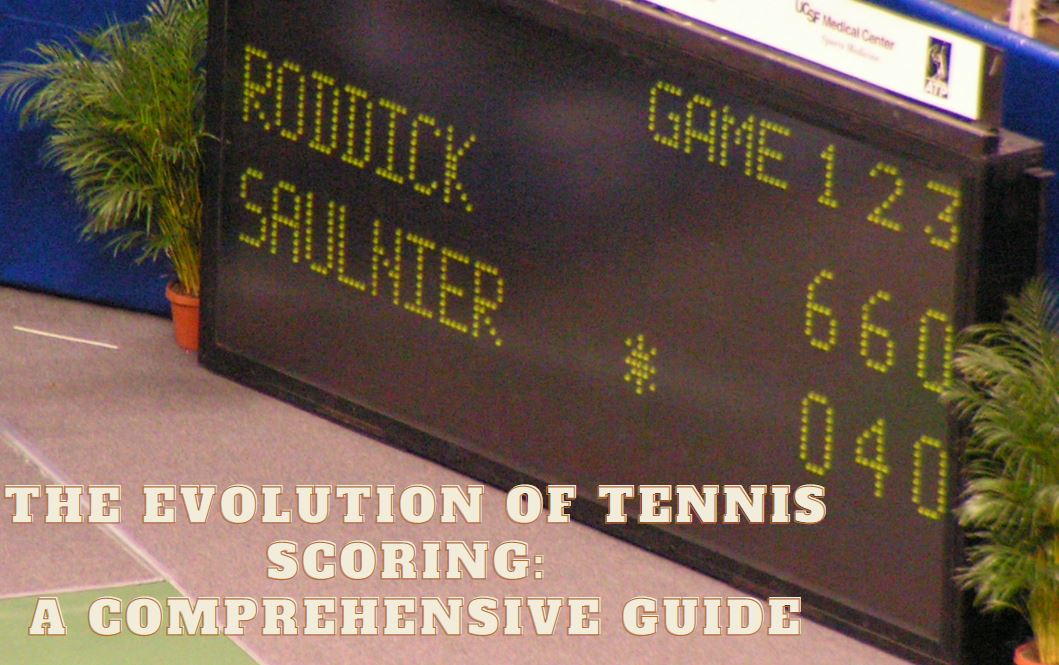If you’re curious about the history of tennis scoring and how it differs from other sports, you’ve come to the right place. The point system in tennis has a rich history and unique origins for each point number.
In this article, we’ll explore the fascinating world of tennis scoring and regulations. Whether you’re a long-time fan or new to the sport, we hope to provide you with valuable insights and answers to your questions. Let’s dive in!
Table Of Contents
- Discover the Origin of Tennis Scoring and How it Has Evolved Over Time
- FAQ’s
- What is the origin and history of the scoring system in tennis?
- When did the current scoring system in tennis originate?
- How is the first point scored in a game of tennis?
- What happens after deuce in tennis and how is the winner determined?
- What is the meaning of Ad in Tennis Scoring?
- How to Understand and Read Tennis Scores?
- What is the term used when a player fails to serve a ball in tennis?
- Finally
Discover the Origin of Tennis Scoring and How it Has Evolved Over Time
The history of tennis scoring dates back to the French game called “jeu de paume,” which used hands instead of rackets. This sport was highly structured due to its close ties to the pageant customs of French courts and was popular among both the nobility and commoners.
The point system in the Middle Ages ranged from 0 to 60, displayed on two watch faces, with a quarter-circle representing 15 points. Over time, the scoring system evolved into 15, 30, 40, which eventually became 15, 30, and 45 due to watch face damage. Today’s scoring system still retains the 15-30-40 format, which makes more sense mathematically.
If you have any further questions about the history of tennis scoring or its regulations, feel free to contact us anytime.

FAQ’s
What is the origin and history of the scoring system in tennis?
If you are interested in tennis tournaments and want to know more about how they work, you have come to the right place. Tennis matches are typically scored using a points system, which is used to determine the outcome of matches, particularly in pick-up games.
Tournaments are usually divided into several categories, including singles and doubles. In most cases, tournaments are played as single-elimination matches, meaning that a player is eliminated from the competition after one defeat. The winner of the tournament is the last player without a loss. To ensure that the tournament is properly organized, the number of contestants in the tournament should be equal to a power of two.
Moreover, the brackets in many professional and high-level amateur tournaments are seeded according to a recognized ranking system. If you have any questions or concerns about tennis tournaments or scoring, feel free to ask.
When did the current scoring system in tennis originate?
The scoring system used in tennis today has its roots in medieval France, specifically in the terms 15, 30, and 40. The number 40 originated from the French word “quarante” which means forty, but the origin of 15 and 30 are less clear.
It is believed that these numbers may have been derived from a game called “paume” played in France in the 12th century, where the clock face was used to keep score, with a quarter turn of the hand equating to 15 points. A Latin statement from 1522 shows the use of the numbers 30 and 45, stating “We are winning 30, we are winning 45.
How is the first point scored in a game of tennis?
In tennis, the scoring system starts from “love” which means zero and goes up to 40, but this means only four points. The first point is scored as 15, followed by 30, then 40. The player who scores the game point wins the game.
What happens after deuce in tennis and how is the winner determined?
In tennis, when both players have scored three points each, the score is referred to as “deuce.” To win a game, a player must score two points in a row after “deuce” and move two points ahead of their opponent. This scoring system is known as “advantage scoring” or “ads.” So, after deuce, the player who scores the next point will be at “advantage,” and if they win the next point as well, they will win the game.
What is the meaning of Ad in Tennis Scoring?
When a tennis game reaches a score of 40-all, which is also known as “deuce,” the term “advantage” is used. To win the game, a player must score two consecutive points after the score is tied at deuce. If a player scores one point after deuce, they gain the advantage as they only need one more point to win the game. However, their opponent still needs to score two more points to win.
How to Understand and Read Tennis Scores?
To understand tennis scoring, it’s essential to know that it operates differently than most other sports. Here’s a guide to scoring each game:
- Love: This represents zero points.
- 15: This equals one point.
- 30: This is two points.
- 40: This equals three points.
- All: This means the score is tied.
- Deuce: This occurs when both players have 40 points, and the winner must score two consecutive points.
- Ad-In: This refers to the server having the advantage after a deuce point.
- Ad-Out: This means the receiver has the advantage after a deuce point.
What is the term used when a player fails to serve a ball in tennis?
If a player fails to hit the ball after making an attempted swing, it is counted as a fault. However, if the server tosses the ball without attempting to hit it, it is not considered a fault, and they can redo their service attempt.
Finally
We hope this article has helped you understand the history and scoring system of tennis. With this knowledge, you’ll be able to converse with seasoned tennis fans and even compete in a tournament with confidence.
If you still have any questions or confusion, please feel free to leave them in the comments section below.
Wishing you all success beyond your expectations! Thank you for reading, and we’ll see you again soon.

